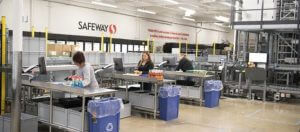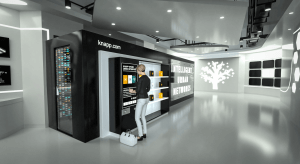Challenges for both brick and mortar and online retailers
Retail is currently trying to square the circle, as the expression goes. On the one hand, in-store shopping has become less and less attractive for customers. The question is: “How do you get in personal contact with customers who spend their time browsing online shops, marketplaces, and social media?” At the same time, sales per unit area and costs for each US dollar of revenue are increasing. On the other hand, online retail has its challenges too. Online business is booming, but there is still room for improvement on the last mile. Delayed deliveries and goods that don’t fulfill expectations result in disappointed customers and returns, which lead to more work and costs.
Online retailers and shop operators alike are asking themselves the same question: How can I reach my customers? The use of intelligent omni-channel automation technologies makes reconciling online and offline markets possible, which, in turn, satisfies customer needs and increases economic efficiency.
What do customers expect when they go shopping?

Omni-channel retail, seamless commerce, and customer experience are shaping today’s retail sector. These new concepts start and end with the end customer and their needs. But what do customers actually expect when they go shopping? Here are some facts, figures, and data about the world of omni-channel retail.
*Sources listed at end of article.
COVID-19 leaves a mark on people’s purchasing behavior
The developments in 2020 caused by the COVID-19 pandemic have left a mark on people’s purchasing behavior. Lockdowns and physical distancing have prompted consumers to shop more online, even the older generation prefers browsing online shops. Business areas such as food retail or DIY have experienced strong growth in their online segment and customers have quickly gotten used to new omni-channel services such as:
- Contactless payment
- Virtual consultation
- Home delivery
- Click & Collect (curbside pick-up, BOPIS)
- Click and reserve

Urban networks for omni-channel fulfillment improve efficiency and help gain customers
With good reason, omni-channel fulfillment is seen as the supreme discipline in logistics. Along with large high-performance fulfillment centers that efficiently supply several countries, smart solutions are becoming increasingly important, especially for urban areas. Urban areas require agile logistics networks where goods flows, people, processes and information are intelligently interconnected to master the challenges on the last mile, in particular.
Four important factors for success in omni-channel retail
How can we translate all these complex challenges into efficient logistics processes?
Keep it simple and seamless.
Our initiative New Urban Logistics equips retailers with the tools to tailor their urban omni-channel networks precisely to their needs. The portfolio provides micro-fulfillment solutions ranging from in-store fulfillment up to the fully integrated software solution that dynamically monitors and controls warehouse stock and route planning.

More convenience and efficiency for the last mile
The last mile turns into the fast mile with micro-fulfillment. A micro-fulfillment center (MFC) is an automated mini-warehouse that is connected to an existing store. This means that the micro-fulfillment center uses the existing store infrastructure to handle online orders quickly and cost-effectively. The micro-fulfillment centers’ design is based on the hub and spoke system, which enables one MFC to process online orders from five stores in its surroundings. The order from the customer is handled in a nearby MFC. A mere 30 minutes after the order is placed, the desired goods are ready: To be picked up using Click & Collect or to be delivered, fast and environmentally friendly by using a cycle courier service, for example. Stock in store can also be housed space-effectively in the automated warehouse – so what is available is always in view. The MFC can also be designed as a dark store.
Many companies , such as Albertsons in the USA or Woolworths in Australia are already using our micro-fulfillment solutions with KNAPP technologies.

Experience and variety: What about a walk-in online shop?
There are different reasons motivating a customer to visit a store. Some customers know exactly what they need and want to find the desired product quickly and easily. Others look for competent technical advice, a good selection, and the chance to compare.
With Project RetailCX, in-store shopping is convenient, attractive, safe, and digital. And most importantly for retailers, it is profitable. A far greater selection can be offered to the customer on a greatly reduced – about 40-70 percent less – surface area. Customers choose the optimal service level that suits them: From fast pick-up at the 24/7 desk to in-depth consultation with exciting product presentations.
Both these needs are combined by Project RetailCX into a single solution: The online shop you can walk into. Project RetailCX is an in-store system comprising an automated mini-warehouse with robots and a fully integrated digitalization solution. The goods are stored, theft-proof, inside the automated miniature warehouse making space savings of 40-70 percent possible. Customers use touch screens or apps to browse through the goods on offer, choose their products, pay at an online terminal and receive their goods immediately. Digital signage, cross-selling, contactless payment, or shopping 24/7 can also be implemented. Project RetailCX takes the pressure off employees, and there is more time for helping customers. The high-cost and people-intensive replenishment of racks, which brings no real benefit to the customer, is no longer necessary. In addition, cashier activities can be fulfilled using Project RetailCX.

There is also an exciting application spectrum for the walk-in stores. Use it as:
- An eye-catcher for product presentation
- A pop-up store in a parking lot
- A dark store for nano-fulfillment
Project RetailCX combines the best of online and in-store shopping: Customers benefit from more choice and faster payment. They can ask for advice, try out the goods, and immediately leave with their purchases.
https://www.youtube.com/watch?v=zoq2OduClsk&t=3s&ab_channel=KNAPPAG
Speed: Optimizing goods flows and costs
It wasn’t that long ago that you knew exactly what the next day would be like. Dispatch routes were planned in waves and routes for delivery to the stores were fixed. Today, everything is different. Because in the omni-channel network, requirements are changing constantly. New online orders come in, there are always other recipients to supply, and new service levels, such as same day delivery or individual delivery times, are being requested.
KiSoft controls a single optical sensor in the warehouse, has an overview of the goods on hand at several locations, and enables dynamic planning of delivery vehicles. The general overview of the conditions and data of the value chain allows systematic and proactive action as well as real-time responses. This makes it possible to lower the costs for the entire fulfillment process, introduce new service levels, and increase delivery quality.
To guarantee this high quality of delivery, retailers are increasingly handling things themselves. Efficient omni-channel fulfillment requires intelligent and integrated planning in the warehouse and on the street. This is the job of KiSoft, with its warehouse management and transport management functions.
- The software checks the resources available in the warehouse and on the street, and plans dynamic routes.
- It also checks the status of the routes regularly and makes adjustments if required.
- This way, resources can be optimally planned and efficiency improved.
- The environment and society as a whole also benefit: Thanks to intelligent route planning, important mileage and time can be saved, and traffic volume decreased.
Would you like to know more about our New Urban Logistics solutions? Write to us at blog@knapp.com.
Sources:
McKinsey (October 19, 2020)
Marketing Research Chart: How do customers want to communicate? | MarketingSherpa
15 Stats to Explain Why Omni-Channel is More Than Just a Buzzword – Business 2 Community
Loyalty360 – Loyalty360 Reads: Daily News | Customer Loyalty, Customer Experience, CRM
15 Stats to Explain Why Omni-Channel is More Than Just a Buzzword – Business 2 Community
Further reading recommendations

The grocery industry is transforming its way into the future. Grocers using MFCs will be the ones getting it right first.

In this blog, we want to illustrate the current realities of shopping, but always with a resolute view towards the future. As restrictions are gradually eased it is now important for brick and mortar pharmacies to communicate safety and trust to bring back customers who are thought to be lost.

How to translate the one of a kind features of brick and mortar stores into unique customer experience? The new in-store system Project: RetailStore helps with this tasks.
Additional Information
How does a MFC work?
https://www.youtube.com/watch?v=_yo-ardpnFA&t=3s&ab_channel=KNAPPAGKNAPPAG
What is the significance of software in our world? How does software facilitate our everyday lives and what role does it play in logistics? Find out more in this video.
https://www.youtube.com/watch?v=8_uMTtQx_14&t&ab_channel=KNAPPAG


